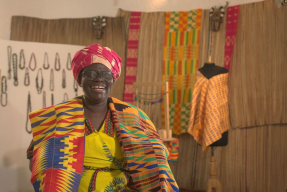The Largest Development Organization in the World (and you probably haven’t heard of it!)
August 28, 2012On my seemingly endless journey from NYC to Kampala, Uganda, I barely slept at all.
Free movies on the plane, my recently updated Spotify playlists, even SkyMall – none of it appealed to me. Why? I was so engrossed in my book, Freedom From Want, that tells the story of BRAC and how it evolved from a small, temporary solution to a devastating cyclone that hit Bangladesh in 1970 to today being the largest development organization in the world by many counts.
We all are familiar with Bangladesh’s other major development export, the Grameen Bank, but what shocked me is how relatively unknown BRAC is outside of development circles in the west.
This year marks BRAC’s 40th anniversary -after growing for 30 years in Bangladesh, BRAC in the past 10 years has expanded to 10 other countries, including Uganda, where it is (no surprise here!) the largest NGO in the country. With operations reaching 2.8 million Ugandans, BRAC Uganda is a true all-in-one development organization with specialized programs from education to health to empowering young women to improving small businesses through microloans.
From what I have seen as a Fellow at BRAC Uganda, I think there are 3 distinct features in many of their programs that make BRAC as an organization so successful. In light of Kiva’s monthly theme “A Global Feast”, I am going to highlight these features in regard to BRAC Uganda’s agricultural development programme. (This is also convenient for me since I’ve been learning a lot about their agriculture programme in preparation to initiate BRAC Uganda’s agricultural loans on Kiva!)
1. Rigorous Monitoring and Evaluation
Researchers are a familiar sight around the BRAC Uganda head office. With a strong Monitoring and Evaluation team, BRAC places a large emphasis on randomized control trials (RCTs) . The idea is that as with medicine, one can effectively and scientifically measure the effects of development programs. This is done through applying different “treatments” to isolated populations and valuing the impact on these different populations quantitatively.
After a year of measuring the impact that a pilot loan program had on rural Ugandan farmers, BRAC Uganda decided that it needed to take a more effective approach and completely revised the agricultural loan program, learning from their mistakes with the original pilot. This is common throughout BRAC’s history – if BRAC finds that a program is not having the desired impact, BRAC will go back to the drawing table to reformulate a plan. This is refreshing to see amid the many development agencies who stick with their original plan to full implementation, regardless of effectiveness.
2. A Focus on Scalability
Over the years, BRAC has developed a penchant for developing entire supply chains if satisfactory sources do not exist.
For example, let’s look at their agricultural program in Uganda. When BRAC could not find a supplier for reliable, cost effective agro-inputs needed on the scale of their desired outreach, BRAC Uganda created BRAC Social Business Enterprises Uganda Ltd to research and produce high yielding maize and rice seed. It is based on a 50 acre research facility near Kampala, where they produce foundation seeds then provided to contract farmers who can pool their land to produce certified seeds that then are sold back at a contracted price to BRAC. To give some sense of scale: this year, 250 tons of seeds will be processed through this operation and in 2013, BRAC is projecting expansion to process around 400 tons of seeds. This is nothing new for BRAC; over the years BRAC has created specialized production entities in everything from salt to tea to sanitary napkins. This ability and willingness to create highly specialized entities to fill gaps in value chains is what has allowed BRAC to expand to its current size in a sustainable manner.
3. Microfinance, Multiplied
Microfinance multiplied is a term coined by BRAC, which is the idea that the impact of its microfinance program can be amplified when paired with its other development programs. A wonderful example of this lies in the BRAC agricultural program, which has established a whole franchise of “Community Agricultural Promoters” (CAPs). These CAPs are selected from existing BRAC microfinance groups and are provided with intensive training on agricultural best practices and access to high-yielding seed varieties and other agro-inputs produced by BRAC. The CAPs can then sell the high yield seeds for profit while providing their entire community with free knowledge about best agricultural practices and technical know-how. This is a beautiful effect: here we have new-found, self-sustaining entrepreneurs helping their entire communities increase their crop yields.
–
A recent interview with a World Bank official said that the average Ugandan farm is producing 40% less than what is produced at nearby research stations. With close to 70% of the population of Uganda relying on agriculture as a primary form of income, the nation’s future economic success will rely on vast improvements in agricultural best practices and inputs. In true BRAC fashion, the BRAC Uganda agriculture program has only been around since 2008 and is already reaching over 100,000 farmers. To close with a fitting quote from BRAC’s founder, Sir Fazle Hasan Abed – “Small is beautiful, but big is necessary.”
I don’t know about you, but I certainly will be on the look out for big things coming out of BRAC in the coming years.
Julie Kriegshaber is a Kiva Fellow with BRAC Uganda. Want to take part in all the action? Keep an eye out in coming months for the BRAC Uganda agricultural loan product on Kiva and in the meantime, there are plenty of other high-impact BRAC Uganda loans to check out!
PREVIOUS ARTICLE
Week in Review: Making sanitation a global issue →NEXT ARTICLE
Kiva Innovations: Tackling energy poverty in sub-Saharan Africa →
















